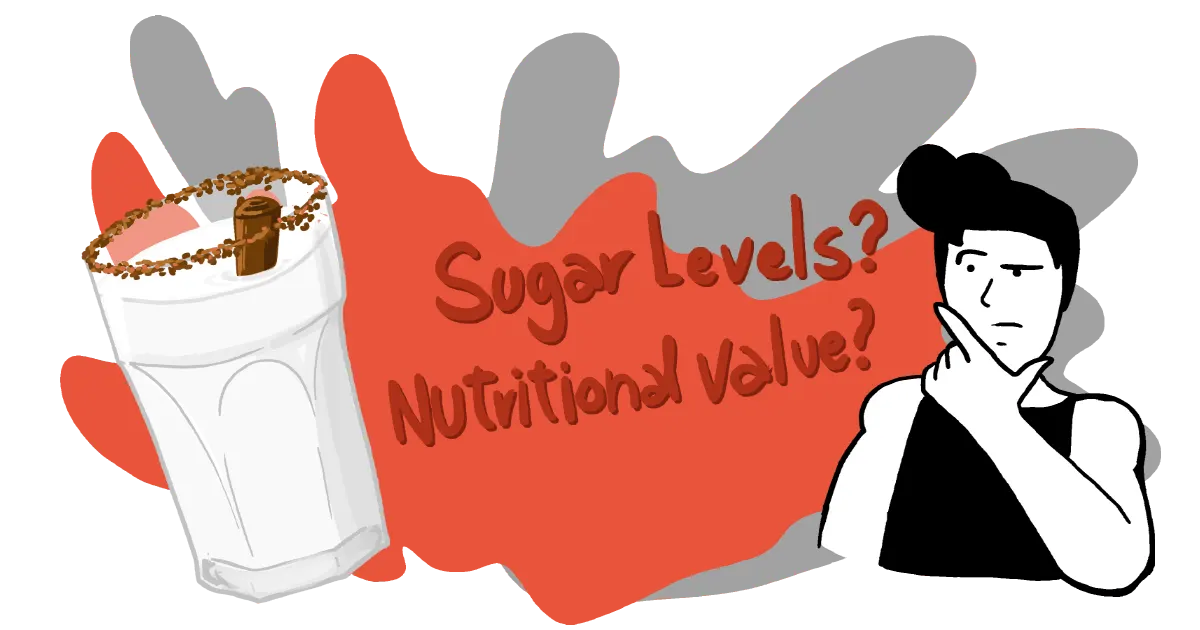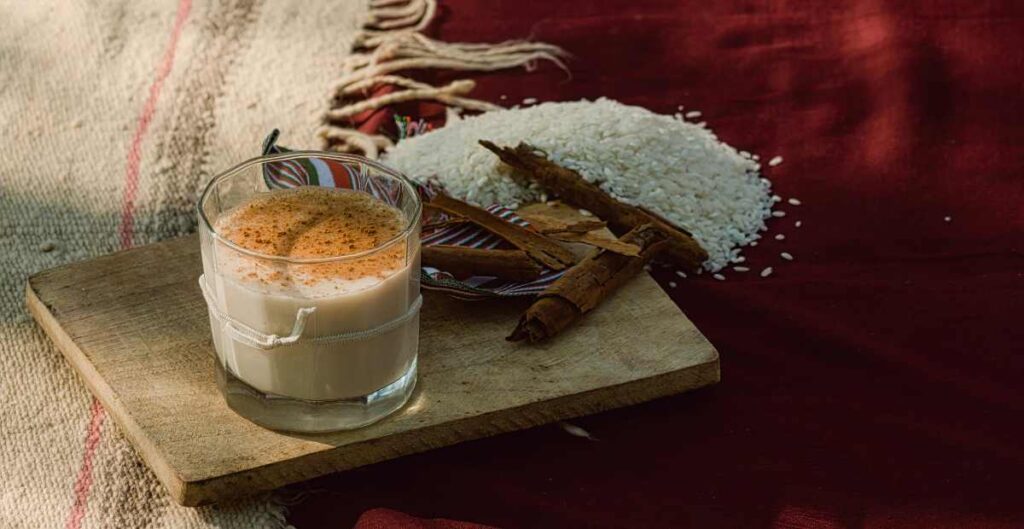
Horchata, a sweet, creamy, nutty beverage often dubbed “the drink of the Gods,” prompts the question of its suitability for mere mortals, especially those considering its impact on weight loss or gain.
Can You Lose Weight Drinking Horchata?
Given that horchata is rich in high-calorie ingredients, it’s challenging to lose weight while consuming it.
Burn more calories than you consume – that’s the basic rule of weight loss. The calories in horchata vary according to region, recipe, and even personal preference, but it’s not a low-calorie drink in any case. So, you can lose weight while drinking horchata, but you have to drink it in moderation.
The best way to lose weight while drinking horchata is to enjoy it once or twice a week if you like a creamy, nutty drink, or prepare a low-calorie version to consume every day if you’re worried about horchata making you fat or being bad for you.
Due to the sugar and rice or nuts it’s made of, drinking too much horchata can be a a slippery slope. If you live in Valencia or Mexico and are planning to drink it in a café, it’ll usually be served with sweets as well, adding to the caloric count.
While horchata isn’t particularly conducive to weight loss, it doesn’t necessarily hinder your efforts to shed pounds either.
Can Horchata Make You Fat? Is it Bad for You?
In most cultures, Horchata has tons of sugar so a couple glasses of horchata can get quite fattening if you’ve a sweet tooth.
Also, anything can be harmful to you if you eat or drink it too often and a diet full of excessive sugar can cause higher levels of abdominal fat.1
Despite the sugar and calories, horchata contains many beneficial vitamins and minerals. It might also serve as a perfect pre-workout snack as the sugar can give you an energy boost so you can work out more intensely.
As long as you drink it in moderation, horchata isn’t inherently bad for your body, just look out for the amount of sugar and calories!
How Many Calories are in Horchata?
Horchata isn’t an off-the-shelf brand that always has the same number of calories. It’s a culinary drink, which means people from different places make it in their unique ways.
In Valencia (and Spain at large), horchata is made from soaked and crushed tiger nuts, while the Mexican variant is made of rice and occasionally almonds. Horchata exists with different names in places like Africa and India, too, containing yogurt and a multitude of regional spices. Nuts are generally high in calories, which makes people question if nutty snacks like horchata and peanut butter and jelly are recommended for losing weight.
So, the calories in horchata vary from place to place. A cup of horchata may have as little as 60 calories if it doesn’t contain any sugar and can go up to 300-400 calories depending on the amount of sugar, yogurt, nuts, and full-fat milk.
Let’s look at the ingredients in horchata and their nutritional info for horchata to figure out why there’s so much variation in calories.
Horchata Nutritional Info

Horchata is high in calories, but it’s not an unhealthy beverage by any means! Here’s the nutritional info for a cup of horchata so you can judge how to include it in your diet.
- Calories: 50 – 400
- Fat: 2 – 8 g
- Protein: 1 – 4 g
- Carbs: 14 – 80 g
- Sugar: 10 – 80 g
Horchata can contribute to weight loss efforts if consumed within a moderate range. It also contains other healthy ingredients that have numerous benefits for your body, depending on where you get your horchata.
- Rice
Rice doesn’t have much nutritional value, but it’s lower in calories than nuts like tiger nuts and almonds. So, while it’s still fattening, a rice-based horchata may be better for weight loss than a nut-based one if you use other low-calorie ingredients.
- Almonds
Almonds are rich in vitamin E, manganese, and magnesium and contain some amount of copper, vitamin B2, and phosphorus. Vitamin E is an antioxidant that can lower your risk of heart disease, cancer, and Alzheimer’s disease.2, 3, 4 At the same time, magnesium can help you control your blood sugar and reduce your risk of diabetes.5
These delicious nuts also reduce harmful cholesterol levels and prevent hunger pangs since they’re high in fiber, promoting weight loss. These nuts can definitely be used to make healthier horchata.
- Tiger Nuts
Tiger nuts, usually used in Valencia, Spain, to make horchata, are a great source of antioxidants, lowering your chances of cancer and heart disease. Rich in fiber, they may help with better digestion and reduce hunger pangs, promoting weight loss.
They also have an amino acid called arginine, which can control blood sugar levels.6. Moreover, they’re heart-healthy because of the high amount of monounsaturated fats, which means they can lower bad cholesterol and promote good cholesterol.7 They may also reduce your risk of blood clots, lowering your chances of a heart attack.
Besides this, they contain decent amounts of iron, phosphorus, vitamin C, magnesium, zinc, potassium, and calcium, all of which are essential for your overall health. Remember, though, that tiger nuts are just one healthy ingredient and you still need to drink horchata in moderation.
- Milk
Both full-fat and low-fat milk is rich in calcium, the mineral that’s essential for strengthening your bones and is lacking in many diets.8 This mineral is vital for middle-aged and post-partum women as their bones weaken with age, making it a great ingredient for creating a healthier horchata.
Besides that, milk also abounds with vitamin D, riboflavin, vitamin B12, potassium, phosphorus, and selenium. A cup of full-fat milk has 8 g of protein, making horchata an excellent post-workout snack as well.
Most of the protein in cow’s milk consists of casein, which provides all nine essential amino acids, in addition to the omega-3 fatty acids in milk, both of which can reduce your risk of diabetes and heart disease.9
Even if you have non-dairy milk, like almond milk or oat milk, most are still high in protein and are available in calcium and vitamin D-fortified varieties.
- Yogurt
Yogurt is a probiotic, so it can improve your digestion and prevent unnecessary bloating. It has the same benefits as milk but may be higher in protein, like Greek yogurt. It’s a great choice if you’re looking to make a healthy, high-protein post-workout horchata.
- Vanilla Extract
Many people use vanilla extract to flavor horchata. While it doesn’t have many health benefits, it contains the antioxidant vanillin, which may reduce your risk of cancer and other diseases, and has anti-inflammatory properties.10
- Cinnamon
Combined with sugar, full-fat milk, and nuts, horchata might not be the best for losing weight, but cinnamon is a tried and true home remedy for weight loss!
It can increase metabolic activity to speed up weight loss and lower cholesterol levels, especially in those with diabetes.11 Cinnamon can also regulate insulin response, reducing cravings and hunger pangs and helping you shed pounds.12 Other than that, it tastes good and adds a kick to your horchata!
As you can see, horchata contains quite a few beneficial ingredients, but the high amounts of sugar and calories can overshadow these benefits. To enjoy the benefits of horchata while still losing weight, try making a low-calorie, healthy horchata!
Make Healthier Horchata
Sugar and nuts are the main culprits for the high caloric content that makes horchata unhealthy. To make a healthier horchata, use sugar substitutes like Splenda to cut down on sugary calories, or just use less sugar than you usually would in a horchata.
Rice might be lower in calories, but you can still use nuts if you want the nutritional benefits. If you’d rather not, use almond milk (or any nut milk) instead of crushed almonds. You can also replace full-fat dairy with low-fat or nut milk to save on calories and add an extra layer of flavor.
However, if these changes sound unsatisfying and you prefer the thick, creamy, sugary horchata, you can enjoy it in moderation a couple of times per week!
While horchata won’t miraculously melt away belly fat overnight, opting for a low-calorie version might contribute to weight loss efforts. Even an authentic horchata won’t hinder your weight loss as long as it fits into your calorie limit. So, if you remain calorie-conscious and don’t have it all the time, horchata isn’t bad for you, and you can indulge guilt-free!
References
1Plain, C. (2020, July 15). Excess sugar linked to dangerous heart and abdominal fat – School of Public Health – University of Minnesota. University of Minnesota School of Public Health. Retrieved February 8, 2022, from <https://www.sph.umn.edu/news/excess-sugar-linked-to-dangerous-heart-and-abdominal-fat/>
2Stampfer, M. J., Hennekens, C. H., Manson, J. E., Colditz, G. A., Rosner, B., & Willett, W. C. (1993). Vitamin E consumption and the risk of coronary disease in women. The New England journal of medicine, 328(20), 1444–1449. <https://pubmed.ncbi.nlm.nih.gov/8479463/>
3Bostick, R. M., Potter, J. D., McKenzie, D. R., Sellers, T. A., Kushi, L. H., Steinmetz, K. A., & Folsom, A. R. (1993). Reduced risk of colon cancer with high intake of vitamin E: the Iowa Women’s Health Study. Cancer research, 53(18), 4230–4237. <https://pubmed.ncbi.nlm.nih.gov/8364919/>
4Morris, M. C., Evans, D. A., Bienias, J. L., Tangney, C. C., & Wilson, R. S. (2002). Vitamin E and cognitive decline in older persons. Archives of neurology, 59(7), 1125–1132. <https://pubmed.ncbi.nlm.nih.gov/12117360/>
5Ryan M. F. (1991). The role of magnesium in clinical biochemistry: an overview. Annals of clinical biochemistry, 28( Pt 1), 19–26. <https://pubmed.ncbi.nlm.nih.gov/2024929/>
6Umeda, M., Hiramoto, M., Watanabe, A., Tsunoda, N., & Imai, T. (2015). Arginine-induced insulin secretion in endoplasmic reticulum. Biochemical and biophysical research communications, 466(4), 717–722. <https://pubmed.ncbi.nlm.nih.gov/26348775/>
7Estruch, R., Ros, E., Salas-Salvadó, J., Covas, M. I., Corella, D., Arós, F., Gómez-Gracia, E., Ruiz-Gutiérrez, V., Fiol, M., Lapetra, J., Lamuela-Raventos, R. M., Serra-Majem, L., Pintó, X., Basora, J., Muñoz, M. A., Sorlí, J. V., Martínez, J. A., Fitó, M., Gea, A., Hernán, M. A., … PREDIMED Study Investigators (2018). Primary Prevention of Cardiovascular Disease with a Mediterranean Diet Supplemented with Extra-Virgin Olive Oil or Nuts. The New England journal of medicine, 378(25), e34. <https://pubmed.ncbi.nlm.nih.gov/29897866/>
8Wadolowska, L., Sobas, K., Szczepanska, J. W., Slowinska, M. A., Czlapka-Matyasik, M., & Niedzwiedzka, E. (2013). Dairy products, dietary calcium and bone health: possibility of prevention of osteoporosis in women: the Polish experience. Nutrients, 5(7), 2684–2707. <https://www.ncbi.nlm.nih.gov/pmc/articles/PMC3738995/>
9Castro-Webb, N., Ruiz-Narváez, E. A., & Campos, H. (2012). Cross-sectional study of conjugated linoleic acid in adipose tissue and risk of diabetes. The American journal of clinical nutrition, 96(1), 175–181. <https://www.ncbi.nlm.nih.gov/pmc/articles/PMC3374738/>
10Li, G., Kong, B., Tong, Q., Li, Y., Chen, L., Zeng, J., Yu, H., Xie, X., & Zhang, J. (2021). Vanillin downregulates NNMT and attenuates NNMT‑related resistance to 5‑fluorouracil via ROS‑induced cell apoptosis in colorectal cancer cells. Oncology reports, 45(6), 110. <https://www.ncbi.nlm.nih.gov/pmc/articles/PMC8082342/>
11Gupta Jain, S., Puri, S., Misra, A., Gulati, S., & Mani, K. (2017). Effect of oral cinnamon intervention on metabolic profile and body composition of Asian Indians with metabolic syndrome: a randomized double -blind control trial. Lipids in health and disease, 16(1), 113. <https://www.ncbi.nlm.nih.gov/pmc/articles/PMC5469078/>
12Jarvill-Taylor, K. J., Anderson, R. A., & Graves, D. J. (2001). A hydroxychalcone derived from cinnamon functions as a mimetic for insulin in 3T3-L1 adipocytes. Journal of the American College of Nutrition, 20(4), 327–336. <https://pubmed.ncbi.nlm.nih.gov/11506060/>